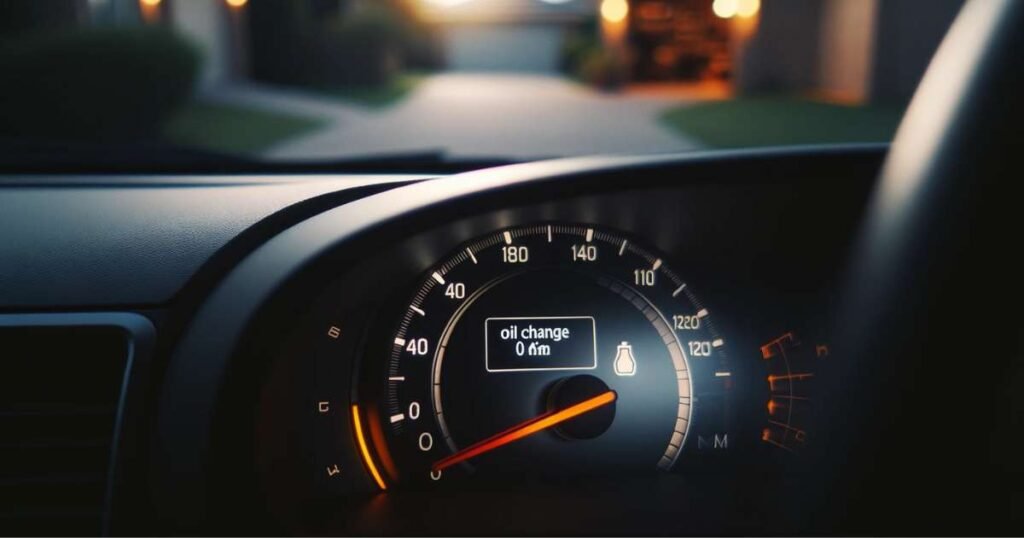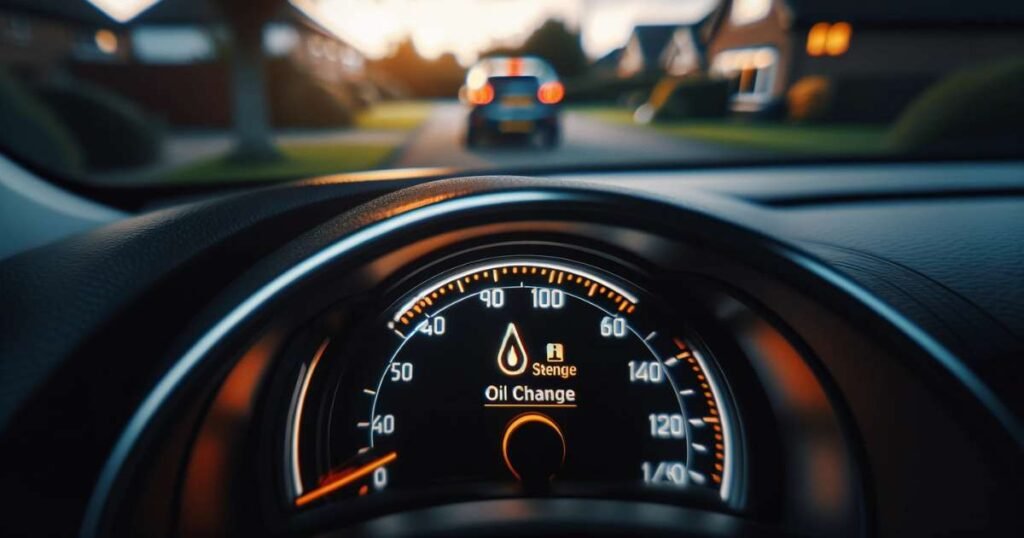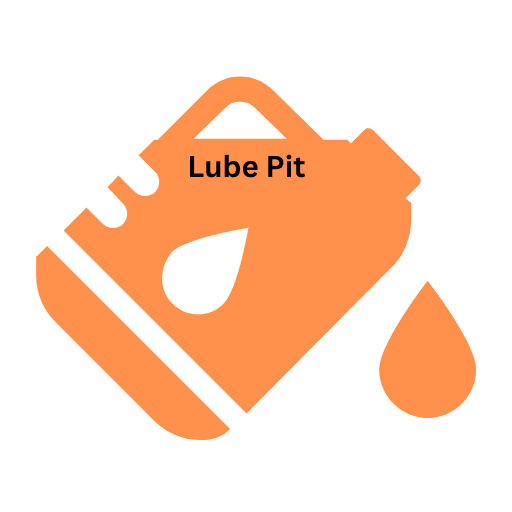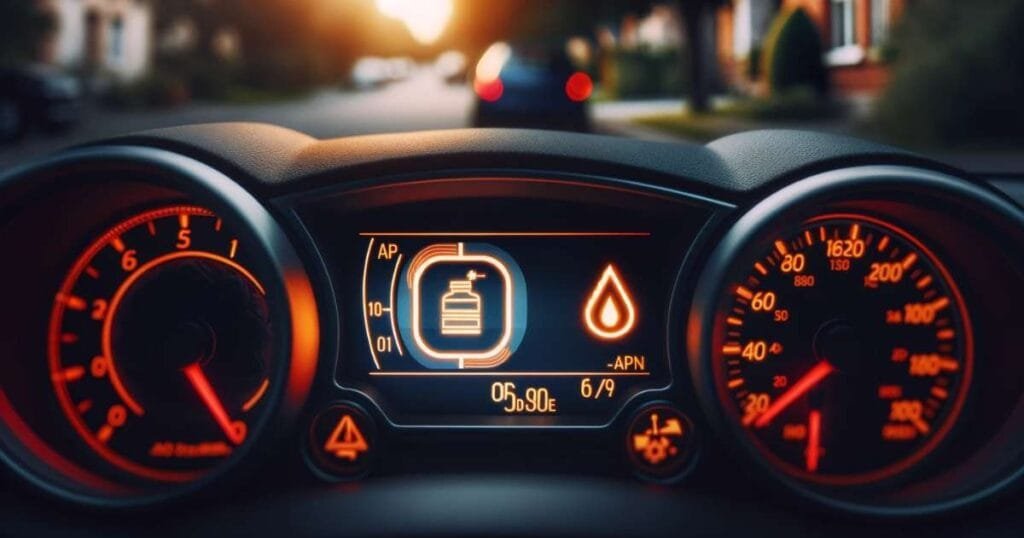That little illuminated symbol on your dashboard – is it a friend or foe? It seems to have a mind of its own sometimes, doesn’t it? Don’t worry, we’re going to decode it together.
Table of Contents
How Long After Oil Change Does the Light Come On?
You’re not staring at an immediate engine meltdown when the oil change light comes on.
Modern indicators are based on your driving habits and the condition of the oil, not just the mileage. Contrary to what some might think, this light isn’t a sign that your engine is about to fail.
The light is part of a notification system that tells you your car’s oil level or pressure is low, which could affect lubrication and engine performance.
While it’s generally safe to drive a short distance to a trusted mechanic, ignoring the light for too long can cause serious damage. Here’s what you need to know:
If the light is steady, you usually have a grace period of 500 to 1,000 miles before needing an oil change. But it’s wise not to push it.
If the light is flashing, it’s more urgent. Try to get an oil change within 200 miles to avoid risking engine damage.

What Exactly Is That Oil Change Light?
Let’s get one thing clear: this light isn’t always a sign of impending doom. But ignoring it? That’s a recipe for disaster.
Is it a Warning or a Reminder?
In most modern vehicles, the oil change light is primarily a reminder based on mileage or time. It’s your car saying, “Hey, remember that oil change we talked about?” It’s not usually triggered by an immediate drop in oil pressure (that’s often a separate warning light).
However, some advanced systems do incorporate sensors to gauge oil quality, making the light a more serious warning in certain cases. If your light illuminates with the oil pressure light and engine is acting sluggish then it means something is wrong and immediate action should be taken.
Does it Measure Oil Quality or Time?
The answer depends on your vehicle. Older cars typically rely on simple mileage counters – think of it as a built-in odometer for your oil.
Newer vehicles often use algorithms that consider driving conditions and may even have sensors to partially assess oil degradation.
It is to be kept in mind that these sensors are not perfect and cannot accurately tell the quality of oil, as they use parameters like pressure and temperature to determine the life of your oil, rather than its viscosity.
This difference highlights the importance of knowing your car’s specific needs.
What Does the Symbol on the Dashboard Actually Mean?
The symbol itself is usually pretty consistent – it’s a picture of an old-school oil can with a drop dripping from its spout. Sometimes, you might see it accompanied by a wrench symbol.
If you’re seeing a different symbol that resembles a genie lamp then it’s oil pressure warning light. This light indicates a more serious issue than the oil change reminder, and usually signals an immediate drop in oil pressure. Consult your owner’s manual for your specific symbol. If it’s oil pressure then stop driving immediately!
How Does My Car Know It Needs an Oil Change?
It’s like your car has a tiny mechanic living inside, or maybe it’s just very sophisticated technology. Let’s find out how it figures things out.
Is it Tracking Miles or Time Since the Last Change?
Most systems track mileage, calculating the time and distance you’ve driven since the last reset. Some systems also calculate based on time, for example; If you use your car very rarely, then the oil will degrade over time even without clocking up many miles.
This is because exposure to air and condensation can reduce its performance. If that’s the case then the light might come on after a certain period. So both factors are important here.
Does it Use Sensors to Monitor Oil Condition?
While the sensor in new cars may attempt to guess the oil condition using algorithms, they don’t directly measure viscosity or chemical breakdown of oil. These sensors analyze factors like temperature and driving behavior which are then used to assume the life of your oil.
Can It Tell the Difference Between Driving Styles?
Absolutely! The algorithms in modern vehicles are smart enough to recognize “severe” driving conditions. Heavy stop-and-go traffic, frequent short trips, and extreme temperatures can cause oil to degrade faster.
Your car will take these conditions into consideration to adjust the timing of your oil light’s appearance.
So, How Long After an Oil Change Does the Light Appear?
This is the million-dollar question, isn’t it? The answer, frustratingly, is that it depends.
Is it an Immediate thing?
The oil change light usually doesn’t come on the moment you drive off after an oil change. If it does, then the light has not been reset, which is a common cause of the light coming on immediately. The system has to be reset manually after an oil change.
Can it come back before its time?
Yes, it can, due to many reasons such as heavy driving conditions or using the wrong oil grade.
Are There Different Timing Triggers for Different Cars?
Yes, the triggers for the light are different for almost all car models.
Does My Model’s Manual Have Specific Guidance?
This is where the boring but essential part comes in: Your owner’s manual! It contains the most accurate information about your car’s specific oil change schedule.
It will tell you the recommended intervals for oil changes based on miles or time, and also if your car uses different parameters. For example, it will specify if your car has a standard interval, or a flexible interval.
Are There Variations Between Conventional and Synthetic Oil?
Absolutely. Synthetic oils are designed to withstand higher temperatures and break down slower than conventional oils. This means you can often go longer between oil changes when using synthetic oil.
However, it’s crucial to follow your vehicle’s recommendations on oil type and change intervals. The use of Synthetic oil will not affect how often the light comes on. Synthetic oils often extend the oil change frequency.
What Should You Do When the Oil Pressure Light Comes On?
Unlike the oil change indicator, the oil pressure light demands immediate attention. This red light signifies a critical drop in oil pressure, which is vital for your engine.
Ignoring this warning can lead to severe consequences, like engine seizures.
If you see this light, pull over safely and turn off the engine right away. Check your oil level using the dipstick. If it’s below the minimum mark, add the appropriate type and weight of oil as specified in your owner’s manual.
Look for signs of leaks. Dripping oil could mean a faulty gasket or seal. If the light stays on after adding oil or you think there’s an internal issue, call for a tow.
A professional mechanic can diagnose and fix the problem.
What Should I Do When the Light Does Come On?
Okay, so the light’s on. Don’t panic, but don’t ignore it either.
How Urgent Is This Warning?
If it’s just the regular oil change reminder light, you have some time to schedule a service. However, if it’s an oil pressure warning light, the situation is more urgent. If the oil pressure light comes on you should stop driving immediately.
Can I Drive With the Light On?
Generally, yes, if it’s just the maintenance light, you have a buffer period. However, ignoring it for long periods could lead to engine damage. Oil change reminders are there for a reason.
When do I need to pull over immediately?
If the oil pressure light turns on with the oil change reminder, you should stop driving immediately. This means that there is an oil flow issue with your vehicle that could damage your engine.

How Much Should an Oil Change Cost?
Oil changes vary in price depending on several factors.
Your car’s make and model can affect the cost. Luxury vehicles often require more expensive synthetic oils.
The type of oil you choose matters too. Conventional, synthetic, and high-mileage oils all have different price points.
Location also plays a role. Costs can differ between regions and service centers.
You can expect to pay anywhere from $30 to $80 for a basic oil change.
When Are Service Centers Open for Oil Changes?
Most service centers operate during regular business hours, which are Monday to Friday from 8:00 AM to 5:00 PM. Some also offer services on Saturday.
Express oil change chains often have extended hours and may even be open on Sundays.
How Long Does an Oil Change Take?
A basic oil change typically takes 30 to 45 minutes. If you opt for additional services, expect to spend more time. Express oil change chains often aim for a 15-minute turnaround.
Relevant: How Long Does an Oil Change Take?
How Can You Prevent the Oil Light from Coming On?
Prevention is always better than a cure!
Regular oil changes are important. Follow your car’s manufacturer-recommended intervals, which are typically between 3,000 and 10,000 miles, depending on the oil type and driving conditions.
Checking your car’s oil level regularly using the dipstick is a simple but effective way to monitor oil health and prevent surprises.
Choosing high-quality oil that meets your car’s specifications ensures optimal engine lubrication and protection.
Consider using synthetic oil. It offers extended oil change intervals and improved engine performance, especially in extreme temperatures.
Final Thought
The oil change light isn’t just a random annoyance; it’s your car’s way of communicating. Understanding what triggers it, how to respond, and how to maintain your oil properly will keep your vehicle running smoothly for many miles to come. So, pay attention to that little symbol – your engine will thank you! Now, if you’ll excuse me, I need to go check my oil!
FAQs
Can I drive with the oil light on?
In an emergency, short-distance driving to a safe location is permissible. However, prolonged driving with the oil light on is highly discouraged and can lead to severe engine damage.
Is it safe to drive with the oil change light on?
Yes, driving for a short period is generally safe with the oil change light on. However, schedule an appointment for an oil change within the next few weeks to avoid engine wear.
What should I do if the oil pressure light comes on?
Stop driving immediately, turn off the engine, and check the oil level. If the level is low, add oil carefully. If the light stays on, even after adding oil, or you suspect a leak, get your car towed to a mechanic.
How often should I change my oil?
Consult your owner’s manual or refer to manufacturer recommendations for your vehicle. Generally, it’s advisable to change your oil every 5,000 to 8,000 kilometers.
How long after the oil change light comes on can you drive?
You have some wiggle room, typically 500-1,000 miles with a steady light, less with a flashing one. But don’t push it – get an oil change soon!
Is it OK to drive with the oil change light on?
Not ideal. Low oil can damage your engine, so get it changed ASAP. Treat a flashing light as urgent.
How much oil is left when the oil light comes on?
It varies, but there’s enough to keep your engine going for a short while. Don’t rely on guessing, though.
How long does the engine light stay on after an oil change?
It should turn off shortly after you start the car. If it doesn’t, there might be another issue. Consult your mechanic.
How much does an oil change cost?
Prices vary depending on oil type, filter quality, and labor costs. Expect to pay between $30 and $80 for a basic oil change.
What happens if I ignore the oil change light?
While not an immediate emergency, neglecting oil changes can lead to sludge buildup, reduced engine performance, and increased fuel consumption.
How do I reset the oil change light?
Most modern vehicles allow you to reset the oil life monitoring system yourself. Consult your owner’s manual for specific instructions.

